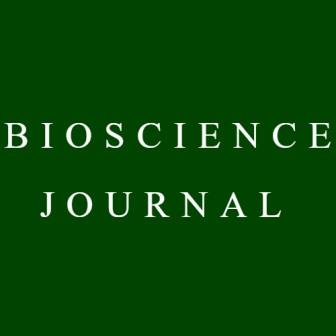Campomanesia spp. native fruits as potential source of health-promoting compounds
DOI:
https://doi.org/10.14393/BJ-v37n0a2021-54318Palavras-chave:
Antioxidant Activity, Bioactive Compounds, Campomanesia xanthocarpa var. littoralis, Campomanesia xanthocarpa, Campomanesia eugenioides, Native Fruits.Resumo
Campomanesia xanthocarpa var. littoralis, Campomanesia xanthocarpa (Berg), and Campomanesia eugenioides are native fruit plants found in Brazil. Due to the scarce number of controlled scientific studies comparing different native Campomanesia species, this study sought to determine their bioactive compounds and antioxidant properties. C. eugenioides proved to be a rich source of total phenolic compounds, also showing the best antioxidant capacity by the ABTS, DPPH and molybdenum reduction power methods. On the other hand, C. xanthocarpa var. littoralis showed the best results for total flavonoids content, and Iron(II) chelation power. The phenolic compounds contents present in C. eugenioides could be responsible for the best antioxidant activity. This study provides key scientific data regarding the use of valuable fruits from different edible Campomanesia species to produce bioactive ingredients, as well as natural preservatives for food products. Thus, our results contribute to the discovery of the potential application of these native Campomanesia Brazilian fruits, as a natural product with functional and antioxidant properties.
Downloads
Referências
BANERJEE, A., DASGUPTA, N. and DE, B. In vitro study of antioxidant activity of Syzygium cumini fruit. Food Chemistry. 2005, 90(4), 727–733. https://doi.org/10.1016/j.foodchem.2004.04.033
BARBIERI, S.F., et al. Extraction, purification and structural characterization of a galactoglucomannan from the gabiroba fruit (Campomanesia xanthocarpa Berg), Myrtaceae family. Carbohydrate Polymers. 2017, 174, 887–895. https://doi.org/10.1016/j.carbpol.2017.07.015
BARROS, R.G.C., et al. Evaluation of bioactive compounds potential and antioxidant activity in some Brazilian exotic fruit residues. Food Research International. 2017, 102, 84–92. https://doi.org/10.1016/j.foodres.2017.09.082
BIAVATTI, M.W., et al. Preliminary studies on Campomanesia xanthocarpa (Berg.) and Cuphea carthagenensis (Jacq.) J.F. Macbr. aqueous extract: weight control and biochemical parameters. Journal of Ethnopharmacology. 2004, 93 (2–3), 385–389. https://doi.org/10.1016/j.jep.2004.04.015
BRAND-WILLIAMS, W., CUVELIER, M. E. and BERSET, C. Use of a free radical method to evaluate antioxidant activity. LWT - Food Science and Technology. 1995, 28 (1), 25–30. https://doi.org/10.1016/S0023-6438(95)80008-5
CARVALHO, A.V., et al. Phenolic composition and antioxidant capacity of bacaba-de-leque (Oenocarpus distichus Mart.) genotypes. Journal of Food Composition and Analysis. 2016, 54, 1–9. https://doi.org/10.1016/j.jfca.2016.09.013
CHEN, G-L., et al. Total phenolic contents of 33 fruits and their antioxidant capacities before and after in vitro digestion. Industrial Crops and Products. 2014, 57, 150–157. https://doi.org/10.1016/j.indcrop.2014.03.018
CONTESSA, C., et al. Total antioxidant capacity and total phenolic and anthocyanin contents in fruit species grown in Northwest Italy. Scientia Horticulturae. 2013, 160, 351–357. https://doi.org/10.1016/j.scienta.2013.06.019
DASTMALCHI, K., et al. Chemical composition and in vitro antioxidative activity of a lemon balm (Melissa officinalis L.) extract. LWT - Food Science and Technology. 2008, 41(3), 391–400. https://doi.org/10.1016/j.lwt.2007.03.007
DEWANTO, V., et al. Thermal Processing Enhances the Nutritional Value of Tomatoes by Increasing Total Antioxidant Activity Thermal Processing Enhances the Nutritional Value of Tomatoes by Increasing Total Antioxidant Activity. Journal of Agricultural and Food Chemistry. 2002, 50, 3010–3014. https://doi.org/10.1021/jf0115589
DONADO-PESTANA, C.M., et al. Polyphenols from Brazilian native Myrtaceae fruits and their potential health benefits against obesity and its associated complications. Current Opinion in Food Science. 2018. 19, 42–49. https://doi.org/10.1016/j.cofs.2018.01.001
DRÖGE, W. Free Radicals in the Physiological Control of Cell Function. Physiological Reviews. 2002, 82(1), 47–95. https://doi.org/10.1152/physrev.00018.2001
HAMINIUK, C.W.I., et al. Chemical, antioxidant and antibacterial study of Brazilian fruits. International Journal of Food Science and Technology. 2011, 46(7), 1529–1537. https://doi.org/10.1111/j.1365-2621.2011.02653.x
HEIM, K.E., TAGLIAFERRO, A.R. and BOBILYA, D.J. Flavonoid antioxidants: Chemistry, metabolism and structure-activity relationships. Journal of Nutritional Biochemistry. 2002, 13(10), 572–584. https://doi.org/10.1016/S0955-2863(02)00208-5
LANDRUM, L.R. and KAWASAKI, M.L. The Genera of Myrtaceae in Brazil: An Illustrated Synoptic Treatment and Identification Keys. Brittonia. 1997, 49(4), 508. https://doi.org/10.2307/2807742
LIMA, D.F., et al. O gênero Campomanesia (Myrtaceae) no estado do Paraná, Brasil. Rodriguésia. 2011, 62 (3), 683–693. https://doi.org/10.1590/2175-7860201162313
MOURA-COSTA, G.F., et al. Antimicrobial activity of plants used as medicinals on an indigenous reserve in Rio das Cobras, Parana, Brazil. Journal of Ethnopharmacology. 2012, 143(2), 631–638. https://doi.org/10.1016/j.jep.2012.07.016
PAZ, M., et al. Brazilian fruit pulps as functional foods and additives: Evaluation of bioactive compounds. Food Chemistry. 2015, 172, 462–468. https://doi.org/10.1016/j.foodchem.2014.09.102
PEREIRA, M.C., et al. Characterization and antioxidant potential of Brazilian fruits from the Myrtaceae family. Journal of Agricultural and Food Chemistry. 2012, 60(12), 3061–3067. https://doi.org/10.1021/jf205263f
PEREIRA, M.C., et al. Characterization, bioactive compounds and antioxidant potential of three Brazilian fruits. Journal of Food Composition and Analysis. 2013, 29(1), 19–24. https://doi.org/10.1016/j.jfca.2012.07.013
PRIETO, P., PINEDA, M. and AGUILAR, M. Spectrophotometric quantitation of antioxidant capacity through the formation of a phosphomolybdenum complex: specific application to the determination of vitamin E. Analytical biochemistry. 1999, 269(2), 337–341. https://doi.org/10.1006/abio.1999.4019
RE, R., et al. Antioxidant activity applying an improved ABTS radical. Free Radical Biology & Medicine. 1999, 26(98), 1231–1237. https://doi.org/10.1016/S0891-5849(98)00315-3
RUFINO, M.S.M., et al. Bioactive compounds and antioxidant capacities of 18 non-traditional tropical fruits from Brazil. Food Chemistry. 2010, 121(4), 996–1002. https://doi.org/10.1016/j.foodchem.2010.01.037
SANTOS, M.S., et al. Quantification of the major bioactive phytochemicals in the gabiroba (Campomanesia xanthocarpa Berg) juice. Acta Scientiarum. Technology. 2013, 35(4), 783–787. https://doi.org/10.4025/actascitechnol.v35i4.13910
SINGLETON, V.L., ORTHOFER, R. and LAMUELA-RAVENTÓS, R.M. Analysis of total phenols and other oxidation substrates and antioxidants by means of folin-ciocalteu reagent. Methods in Enzymology. 1999, 299, 152–178. https://doi.org/10.1016/S0076-6879(99)99017-1
VALLILO, M.I., et al. Características físicas e químicas dos futos do cambucizeiro (Campomanesia phaea). Revista Brasileira de Fruticultura. 2005, 27(2), 241–244. https://doi.org/10.1590/S0100-29452005000200014
VALLILO, M.I., et al. Composição química dos frutos de Campomanesia xanthocarpa Berg-Myrtaceae. Ciência e Tecnologia de Alimentos. 2008, 28, 231–237. https://doi.org/10.1590/S0101-20612008000500035
VASCO, C., RUALES, J. and KAMAL-ELDIN, A. Total phenolic compounds and antioxidant capacities of major fruits from Ecuador. Food Chemistry. 2008, 111(4), 816–823. https://doi.org/10.1016/j.foodchem.2008.04.054
Downloads
Publicado
Como Citar
Edição
Seção
Licença
Copyright (c) 2021 Silvani Verruck, Anildo Cunha Junior, Marcelo Maraschin, Nei Fronza, Jean Carlos Budke, Guilherme de Souza Hassemer, Elane Schwinden Prudencio, Sheila Mello da Silveira

Este trabalho está licenciado sob uma licença Creative Commons Attribution 4.0 International License.






